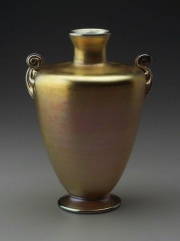Difference between revisions of "Iridescent glass"
m (Text replace - "== Authority ==" to "== Sources Checked for Data in Record ==") |
|||
| Line 16: | Line 16: | ||
iriserend glas (Ned.); vidro iridescente (Port.) | iriserend glas (Ned.); vidro iridescente (Port.) | ||
| − | == | + | == Sources Checked for Data in Record == |
* ''Dictionary of Building Preservation'', Ward Bucher, ed., John Wiley & Sons, Inc., New York City, 1996 | * ''Dictionary of Building Preservation'', Ward Bucher, ed., John Wiley & Sons, Inc., New York City, 1996 | ||
Revision as of 05:42, 1 May 2016
Description
Any Glass with a shimmery iridescent surface. Iridescent glass was first made in 1863 by Llobmeyr. It is made by one of three types of processes:
1) The glass is placed in a reducing flame to reduce oxides near the surface to their metallic state.
2) The glass in placed in a sealed container with metallic salt fumes. Stannous chloride is most often used.
3) The glass is painted with a thin metallic luster paint then fired. The metallic luster paint was composed of a metallic salt in a natural resin binder.
Iridescent glass was used by Tiffany and other art glass companies. The most popular type of iridescent glass was mother-of-pearl. It was made with a thin coating of bismuth.
Synonyms and Related Terms
iriserend glas (Ned.); vidro iridescente (Port.)
Sources Checked for Data in Record
- Dictionary of Building Preservation, Ward Bucher, ed., John Wiley & Sons, Inc., New York City, 1996
